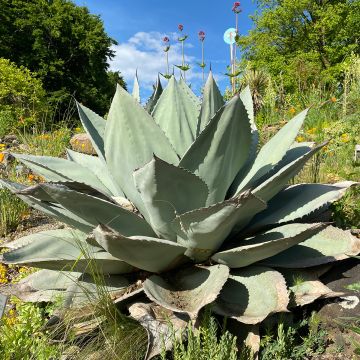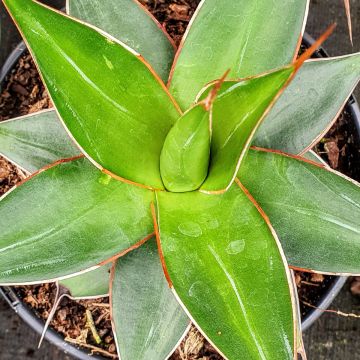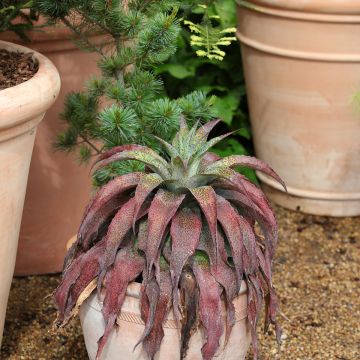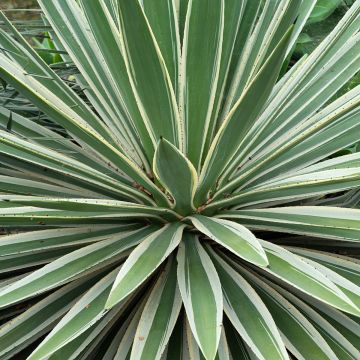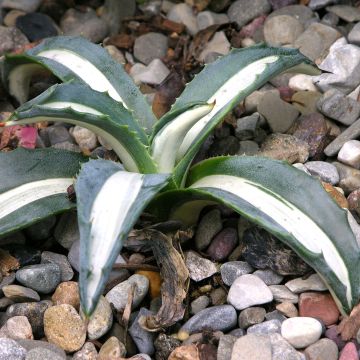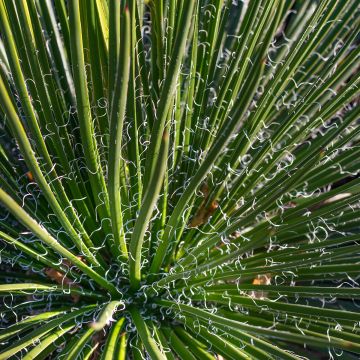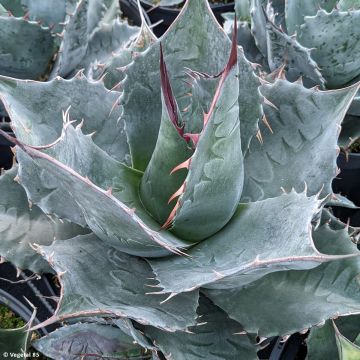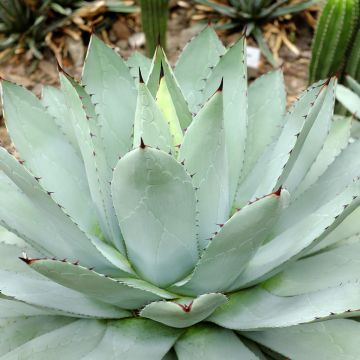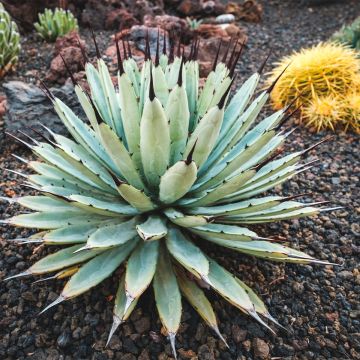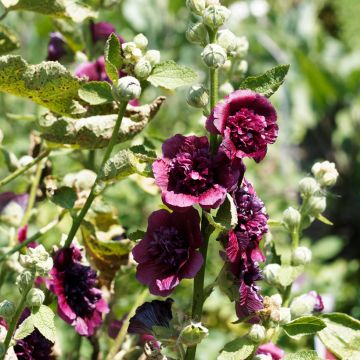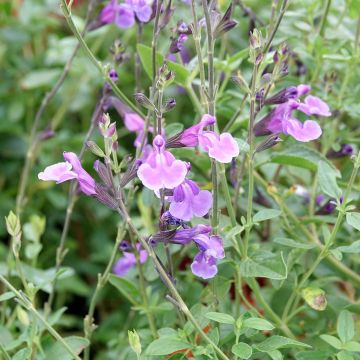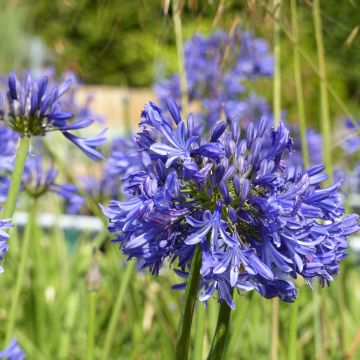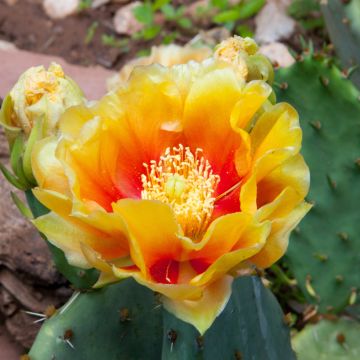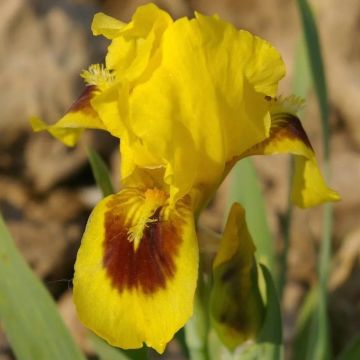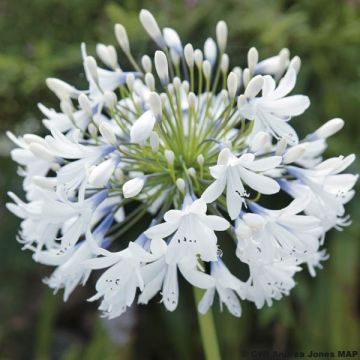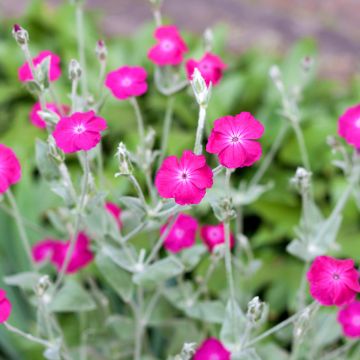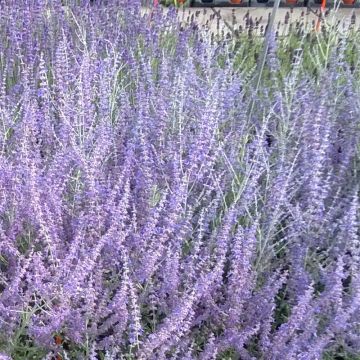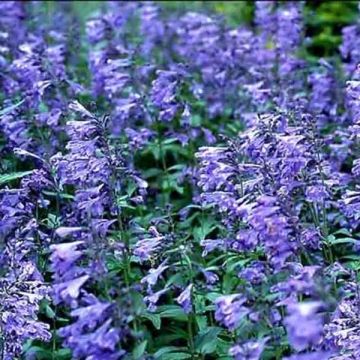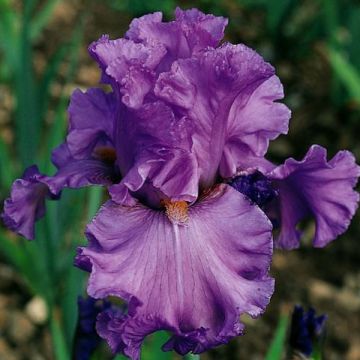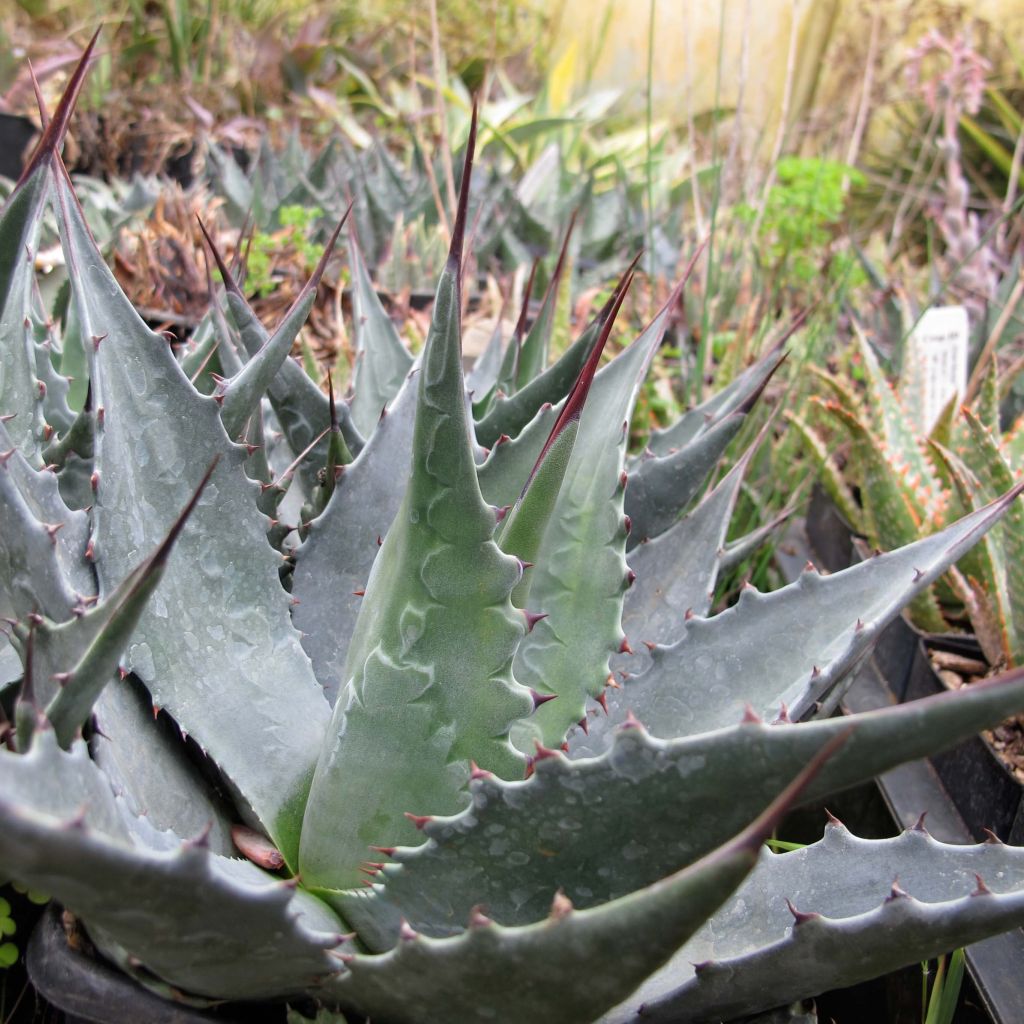

Agave montana - Agave des montagnes.
Agave montana
Agave montana
Mountain agave
This item cannot be shipped to the selected country
Delivery charge from €5.90
More information
Schedule delivery date,
and select date in basket
This plant carries a 12 months recovery warranty
More information
We guarantee the quality of our plants for a full growing cycle, and will replace at our expense any plant that fails to recover under normal climatic and planting conditions.
From €5.90 for pickup delivery and €6.90 for home delivery
Express home delivery from €8.90.
Does this plant fit my garden?
Set up your Plantfit profile →
Description
Agave montana, or Mountain Agave, is not a desert plant but a robust mountain species that is quite easy to acclimatise in our gardens. Its hardiness is often highlighted, which is quite exceptional for a plant with such an exotic appearance, but its resistance to intense frost is only confirmed if the plant is grown in perfectly drained soil and under a dry climate, without winter rains. This rare species reproduces only by sowing. It charms with the beautiful contrast of colours offered by its large leaves, which are partially powdered with white and adorned with lateral and terminal spines of a coppery orange. Its rosette blooms like a flower, in a regular cup shape, composed of numerous overlapping leaves. With a fierce armour that requires a certain distance from high-traffic areas, it possesses a unique architectural presence that can be enjoyed in full sun or partial shade, in a large rock garden, on a slope, or in an elevated bed, in most regions.
While recognising agaves can sometimes be a specialist affair, Agave montana presents unique characteristics that make it difficult to confuse with any other plant.
Discovered in the late 90s growing between 3000 and 3500m (9843ft and 11483ft) altitude in the clear understory of mountains located in northeastern Mexico, it is a rather slow-growing botanical species belonging to the Asparagaceae family (formerly Agavaceae), just like yuccas or tuberose. This perennial succulent plant has rhizomes that generally reproduce through its seeds and never produces daughter rosettes. It is almost devoid of aerial stems. Its dense rosette, in the shape of an upright cup, will reach an average height of 1m (3ft) and a diameter of 1.2m (4ft) at maturity. It is composed of bright green leaves, whose base is irregularly covered with a white bloom, forming wavelets of light on the plant's epidermis. They are wide at the base, rather concave, upright, and taper with an acute angle towards the tip. The end of each leaf terminates in a long spine of coppery orange colour. The edge of the leaves is provided with regularly spaced spines of the same orange tone. When a rosette is mature, after many years, it produces a floral stem that can reach a height of 3m (10ft). It bears a few horizontal branches. The branches bear flat and spherical panicles. The rosette, characterised as semelparous, dies after flowering, which lasts several months.
This very hardy agave will find its place in a large rock garden, a south-facing slope, or at the edges of a dry garden, where its remarkably architectural silhouette will stand out against a mineral backdrop, punctuated by some wild grasses such as Stipa ichu or Stipa gigantea. It can be planted with all kinds of hardy plants with exotic looks, such as Prickly Pears and other Opuntias, Ferula communis, and quite hardy columnar cacti (Cleistocactus strausii, Cylindropuntia imbricata), which are all equally undemanding plants. A good way to highlight agaves is to place ground cover plants for dry soil at their feet: evening primroses, Osteospermum, dwarf artemisias, Ceratostigma plumbaginoides, and Delosperma cooperi, whose foliage will cover the gap left by a dead plant. This agave can also be cultivated in a pot on a terrace, among a collection of cacti, by carefully choosing the sunniest spot. Remember to keep this beautiful plant away from high-traffic areas and young children!
Agave is also an edible plant, used in Mexico to make mescal, an alcoholic beverage obtained by fermenting its sugar-rich juice. It is also used in traditional medicine in Mexico, Brazil, and India, and it has proven antifungal properties. Its inflorescences are very attractive to many pollinating insects.
Report an error about the product description
Agave montana in pictures
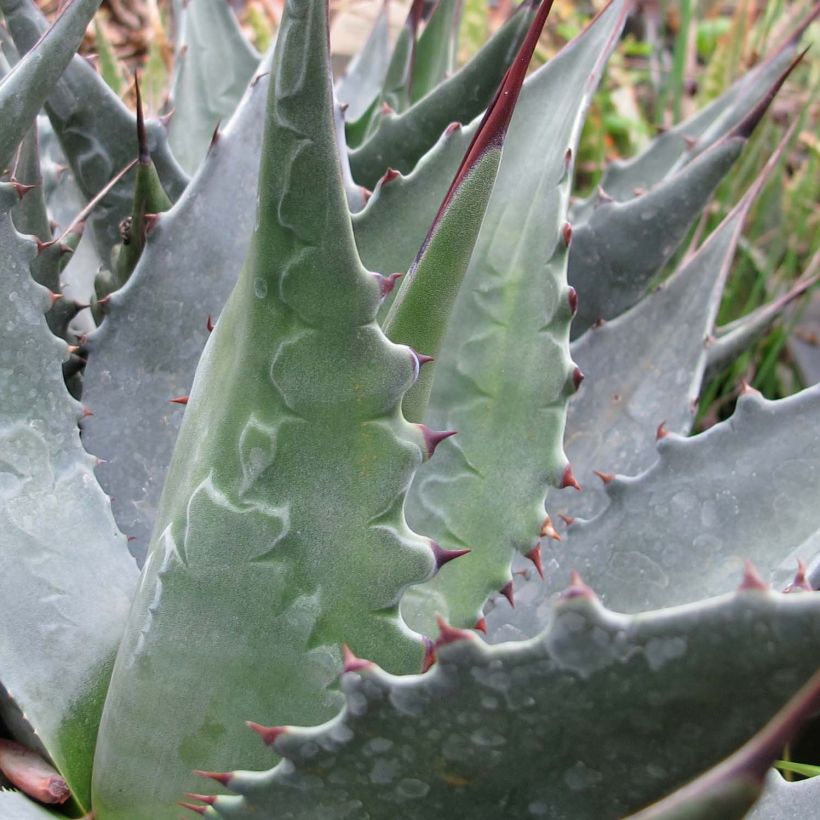

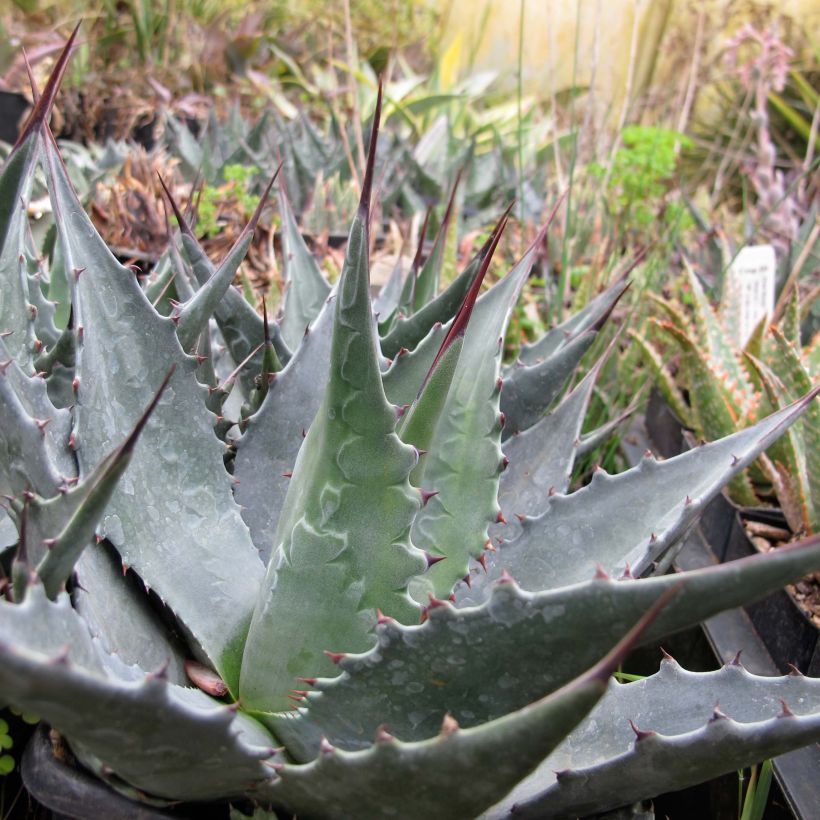

Flowering
Foliage
Plant habit
Botanical data
Agave
montana
Agavaceae
Mountain agave
North America
Other Agave
Planting and care
Plant Agave montana in full sun or even in partial shade, in clear undergrowth. It will thrive on a slope or a dry embankment, in preferably poor, very rocky, sandy, acidic, neutral or calcareous soil, which is very well-drained. The plant is remarkably hardy in dry soil, but it cannot tolerate excess humidity, which is common in clayey and heavy soils, combined with severe cold and winter rains. As it tolerates dry soils well in summer, you can consider digging a 50cm (20in) hole, filling it with a mixture of stones and light soil, and planting the agave in it, with the collar isolated from stagnant water. Abundant but spaced watering will suit it perfectly to help it establish. The drier the soil, the more it will resist frost, up to about -20°C (-4°F).
Pot cultivation:
As the plant has quite significant growth, it can be grown in a large pot (preferably terracotta) on a terrace or balcony, in a light substrate such as cactus soil, with particularly careful drainage. It will then be easy to store the pot away from humidity, under a shelter or in a bright, airy, minimally heated space (between 0 to -5°C (32 to 23°F)). Reduce or even stop watering in winter. The plant can spend April to October outdoors. When you take it out, gradually acclimatise it to the sun to avoid leaf burn by placing it in partial shade for 2 to 3 weeks before facing full sun.
Propagation by sowing fresh seeds.
Planting period
Intended location
Care
-
, onOrder confirmed
Reply from on Promesse de fleurs
Mediterranean perennials
Haven't found what you were looking for?
Hardiness is the lowest winter temperature a plant can endure without suffering serious damage or even dying. However, hardiness is affected by location (a sheltered area, such as a patio), protection (winter cover) and soil type (hardiness is improved by well-drained soil).

Photo Sharing Terms & Conditions
In order to encourage gardeners to interact and share their experiences, Promesse de fleurs offers various media enabling content to be uploaded onto its Site - in particular via the ‘Photo sharing’ module.
The User agrees to refrain from:
- Posting any content that is illegal, prejudicial, insulting, racist, inciteful to hatred, revisionist, contrary to public decency, that infringes on privacy or on the privacy rights of third parties, in particular the publicity rights of persons and goods, intellectual property rights, or the right to privacy.
- Submitting content on behalf of a third party;
- Impersonate the identity of a third party and/or publish any personal information about a third party;
In general, the User undertakes to refrain from any unethical behaviour.
All Content (in particular text, comments, files, images, photos, videos, creative works, etc.), which may be subject to property or intellectual property rights, image or other private rights, shall remain the property of the User, subject to the limited rights granted by the terms of the licence granted by Promesse de fleurs as stated below. Users are at liberty to publish or not to publish such Content on the Site, notably via the ‘Photo Sharing’ facility, and accept that this Content shall be made public and freely accessible, notably on the Internet.
Users further acknowledge, undertake to have ,and guarantee that they hold all necessary rights and permissions to publish such material on the Site, in particular with regard to the legislation in force pertaining to any privacy, property, intellectual property, image, or contractual rights, or rights of any other nature. By publishing such Content on the Site, Users acknowledge accepting full liability as publishers of the Content within the meaning of the law, and grant Promesse de fleurs, free of charge, an inclusive, worldwide licence for the said Content for the entire duration of its publication, including all reproduction, representation, up/downloading, displaying, performing, transmission, and storage rights.
Users also grant permission for their name to be linked to the Content and accept that this link may not always be made available.
By engaging in posting material, Users consent to their Content becoming automatically accessible on the Internet, in particular on other sites and/or blogs and/or web pages of the Promesse de fleurs site, including in particular social pages and the Promesse de fleurs catalogue.
Users may secure the removal of entrusted content free of charge by issuing a simple request via our contact form.
The flowering period indicated on our website applies to countries and regions located in USDA zone 8 (France, the United Kingdom, Ireland, the Netherlands, etc.)
It will vary according to where you live:
- In zones 9 to 10 (Italy, Spain, Greece, etc.), flowering will occur about 2 to 4 weeks earlier.
- In zones 6 to 7 (Germany, Poland, Slovenia, and lower mountainous regions), flowering will be delayed by 2 to 3 weeks.
- In zone 5 (Central Europe, Scandinavia), blooming will be delayed by 3 to 5 weeks.
In temperate climates, pruning of spring-flowering shrubs (forsythia, spireas, etc.) should be done just after flowering.
Pruning of summer-flowering shrubs (Indian Lilac, Perovskia, etc.) can be done in winter or spring.
In cold regions as well as with frost-sensitive plants, avoid pruning too early when severe frosts may still occur.
The planting period indicated on our website applies to countries and regions located in USDA zone 8 (France, United Kingdom, Ireland, Netherlands).
It will vary according to where you live:
- In Mediterranean zones (Marseille, Madrid, Milan, etc.), autumn and winter are the best planting periods.
- In continental zones (Strasbourg, Munich, Vienna, etc.), delay planting by 2 to 3 weeks in spring and bring it forward by 2 to 4 weeks in autumn.
- In mountainous regions (the Alps, Pyrenees, Carpathians, etc.), it is best to plant in late spring (May-June) or late summer (August-September).
The harvesting period indicated on our website applies to countries and regions in USDA zone 8 (France, England, Ireland, the Netherlands).
In colder areas (Scandinavia, Poland, Austria...) fruit and vegetable harvests are likely to be delayed by 3-4 weeks.
In warmer areas (Italy, Spain, Greece, etc.), harvesting will probably take place earlier, depending on weather conditions.
The sowing periods indicated on our website apply to countries and regions within USDA Zone 8 (France, UK, Ireland, Netherlands).
In colder areas (Scandinavia, Poland, Austria...), delay any outdoor sowing by 3-4 weeks, or sow under glass.
In warmer climes (Italy, Spain, Greece, etc.), bring outdoor sowing forward by a few weeks.

































